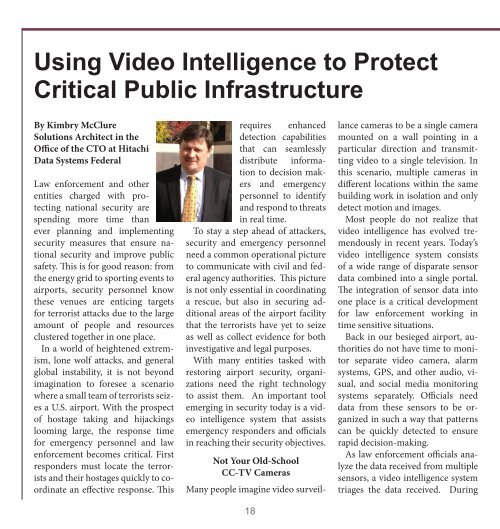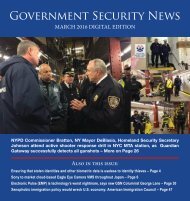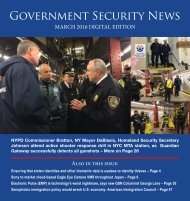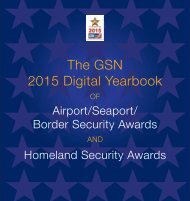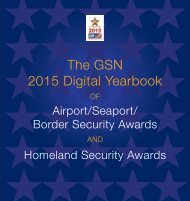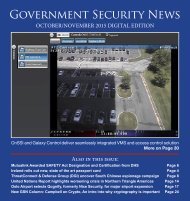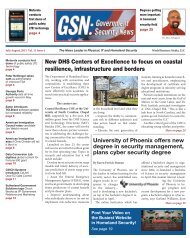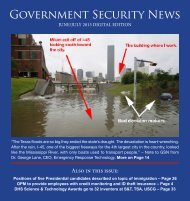GSN January 2016 Digital Edition
You also want an ePaper? Increase the reach of your titles
YUMPU automatically turns print PDFs into web optimized ePapers that Google loves.
Using Video Intelligence to Protect<br />
Critical Public Infrastructure<br />
By Kimbry McClure<br />
Solutions Architect in the<br />
Office of the CTO at Hitachi<br />
Data Systems Federal<br />
Law enforcement and other<br />
entities charged with protecting<br />
national security are<br />
spending more time than<br />
ever planning and implementing<br />
security measures that ensure national<br />
security and improve public<br />
safety. This is for good reason: from<br />
the energy grid to sporting events to<br />
airports, security personnel know<br />
these venues are enticing targets<br />
for terrorist attacks due to the large<br />
amount of people and resources<br />
clustered together in one place.<br />
In a world of heightened extremism,<br />
lone wolf attacks, and general<br />
global instability, it is not beyond<br />
imagination to foresee a scenario<br />
where a small team of terrorists seizes<br />
a U.S. airport. With the prospect<br />
of hostage taking and hijackings<br />
looming large, the response time<br />
for emergency personnel and law<br />
enforcement becomes critical. First<br />
responders must locate the terrorists<br />
and their hostages quickly to coordinate<br />
an effective response. This<br />
requires enhanced<br />
detection capabilities<br />
that can seamlessly<br />
distribute information<br />
to decision makers<br />
and emergency<br />
personnel to identify<br />
and respond to threats<br />
in real time.<br />
To stay a step ahead of attackers,<br />
security and emergency personnel<br />
need a common operational picture<br />
to communicate with civil and federal<br />
agency authorities. This picture<br />
is not only essential in coordinating<br />
a rescue, but also in securing additional<br />
areas of the airport facility<br />
that the terrorists have yet to seize<br />
as well as collect evidence for both<br />
investigative and legal purposes.<br />
With many entities tasked with<br />
restoring airport security, organizations<br />
need the right technology<br />
to assist them. An important tool<br />
emerging in security today is a video<br />
intelligence system that assists<br />
emergency responders and officials<br />
in reaching their security objectives.<br />
Not Your Old-School<br />
CC-TV Cameras<br />
18<br />
Many people imagine video surveillance<br />
cameras to be a single camera<br />
mounted on a wall pointing in a<br />
particular direction and transmitting<br />
video to a single television. In<br />
this scenario, multiple cameras in<br />
different locations within the same<br />
building work in isolation and only<br />
detect motion and images.<br />
Most people do not realize that<br />
video intelligence has evolved tremendously<br />
in recent years. Today’s<br />
video intelligence system consists<br />
of a wide range of disparate sensor<br />
data combined into a single portal.<br />
The integration of sensor data into<br />
one place is a critical development<br />
for law enforcement working in<br />
time sensitive situations.<br />
Back in our besieged airport, authorities<br />
do not have time to monitor<br />
separate video camera, alarm<br />
systems, GPS, and other audio, visual,<br />
and social media monitoring<br />
systems separately. Officials need<br />
data from these sensors to be organized<br />
in such a way that patterns<br />
can be quickly detected to ensure<br />
rapid decision-making.<br />
As law enforcement officials analyze<br />
the data received from multiple<br />
sensors, a video intelligence system<br />
triages the data received. During


